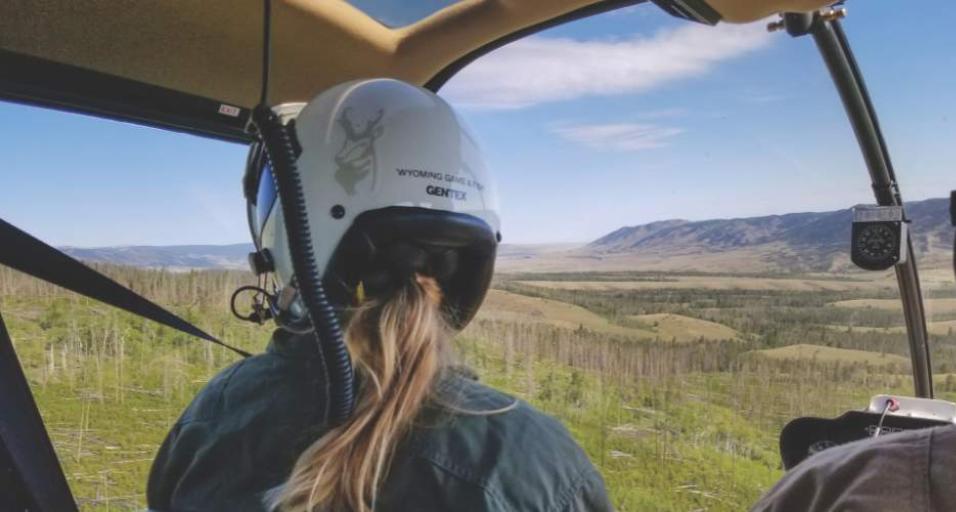All research begins with a question. For Wyoming Game and Fish Department wildlife management teams, finding the best method to answer that question can be half of the battle. Since 2021, the Science, Research and Analytical Support Unit, or SRA, has been changing the timeline on reaching those answers by providing streamlined and innovative approaches to the research process.
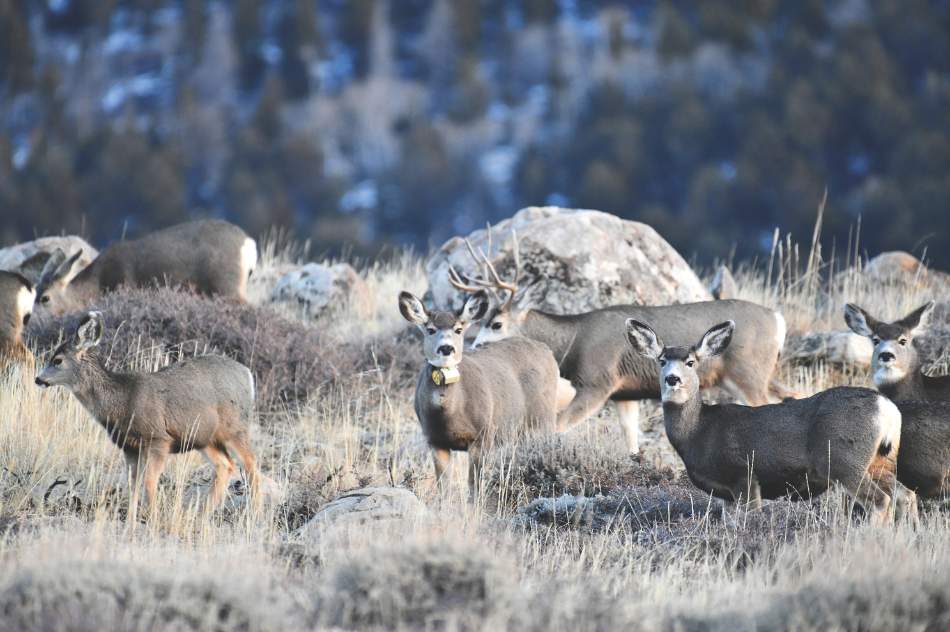
The Science, Research and Analytical Support Unit has played a big role in the Game and Fish's Mule Deer Focal Herd Project, which started in 2022. (Photo by Stan Harter/WGFD)
“A goal of SRA is to build up science capacity within the organization,” SRA Unit Supervisor Embere Hall said. “We are able to assist with everything from enhancing managers’ ability to use the data that the agency has already collected, to collecting data to answer new questions and strengthening our partnerships with research collaborators such as the University of Wyoming.”
The collaborative spirit of the SRA unit is making a significant difference, according to Cheyenne Stewart, Game and Fish wildlife management coordinator in the Jackson Region.
“Our responsibility is to manage wildlife as a public trust,” said Stewart.“The SRA staff are essential in helping us navigate the complexities of ecological systems and the diverse needs and expectations of the public."
SRA personnel have dedicated their careers to the betterment of Wyoming’s wildlife, working long hours in the field and office to provide in-depth data analysis that is shaping and changing how Game and Fish manages wildlife. The innovations they have made not only provide precise and accurate information, but they are also reshaping how managers prioritize and tackle their research load in a region.
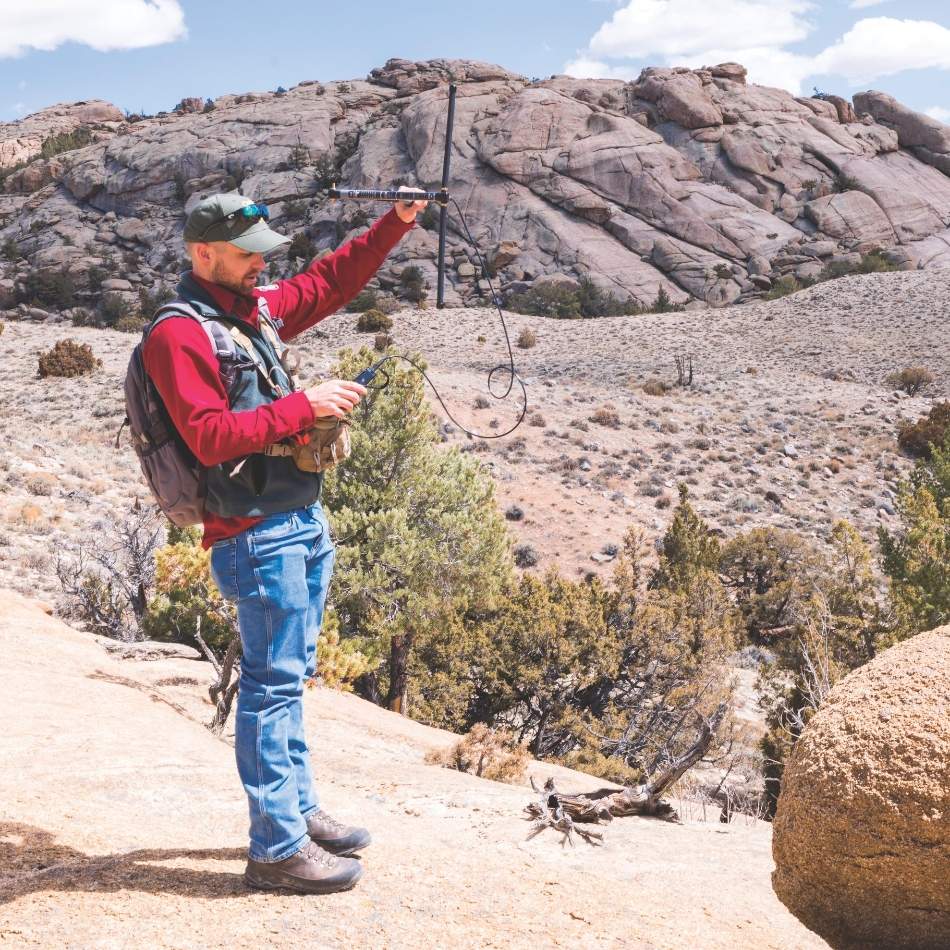
Lucas Olson, Game and Fish quantitative wildlife biologist, uses radiotelemetry to locate a mule deer GPS collar in the Sweetwater Rocks area. Recovering GPS collars is crucial for wildlife research to gather vital data on animal movement and behavior. (Photo by Mark Nelson/WGFD)
Prior to the establishment of SRA, Stewart said that research projects followed along several paths: In-house research, which often competed with other workload needs and priorities; collaboration with student researchers, who had competing demands for their own priorities; or contracting the research out, a process that would take additional time, funding and compete with other statewide initiatives and priorities.
While each of these paths continues to play an important role, with SRA, regions now have more internal resources to draw on, working with team members already familiar with Game and Fish’s priorities and regional personnel. SRA also helps to streamline the process of integrating outside resources, which are often critical to addressing key information gaps.
The ability to work directly with SRA staff to assess what tools to utilize for a project has been effective in increasing the agency’s capacity and efficiency to execute management projects, both for short and long-term needs.
“Our collaborations with universities and partnerships with private contractors are invaluable,” Stewart said. “At the same time, the SRA unit plays a unique role — providing in-house expertise that helps wildlife managers apply modern techniques and technologies to make smarter, more effective decisions. It’s a level of support that external resources alone can’t replicate."
One example of SRA-led research efforts in Wyoming is the Mule Deer Focal Herd Project, which was initiated in 2022. Stemming from a need to better understand the behavior and population trends of mule deer across the state, SRA worked closely with research partners, including the University of Wyoming, to begin a top-to-bottom enhancement of how the agency monitors mule deer. The effort, now one of the largest mule deer studies in North America, evaluates survival rates, movement patterns and important habitats of mule deer in five intensely studied populations. Utilizing GPS collars, the team has been able to provide near real-time reports to biologists, greatly accelerating the ability to gather and process data.
Data gathered from collars and aerial surveys has provided SRA researchers and regional managers with a new understanding of how mule deer interact and move across herd units and has provided the further advantage of in-depth data maps that closely track herd movement in real time. Armed with this new information, department personnel are putting strategic management actions in place to help address time-sensitive conservation needs.
Herd units, the spatial boundaries of a species’ population, are intended to reflect the area where animals in a population are born, reproduce, face harvest pressure and die.
Hall said this refined data is now informing potential changes to herd unit boundaries, which are crucial for accurate sampling, monitoring, and ultimately determining population status and harvest management.
“The real advantage of the SRA model is that we get to work in partnership with the people that are using the data to make decisions on the ground,” Hall said.
The SRA Unit operates with a clear and concise mission: to elevate the quality, capacity and practical application of science within the Game and Fish’s Wildlife Division, ultimately supporting better management of Wyoming's wildlife.
Working closely with managers, supporting their needs wherever needed, it assists Game and Fish in leading and shaping research, supporting manager-led research projects, or collaborating with outside agencies, organizations and graduate students, the unit works to fit whatever mold is necessary to achieve the objectives the region may have.
SRA is also allowed to be creative and introduce cutting-edge methods to improve the process of data collection and analysis. Hall said this ability, fundamental to scientific research, further strengthens the unit’s potential.
One example of SRA's innovation is the J* — a data-gathering aid currently under development. Named for the Steller's jay, known for its vocal prowess and spatial memory, the J* is revolutionizing aerial data gathering in Wyoming.

Garrett Catlin, data scientist with Game and Fish, solders parts of a J* device. The device is revolutionizing aerial data gathering in the state by allowing researchers to input data through voice commands. (Photo by Hannah Guthrie)
Traditionally, wildlife managers flying over populations for species counts, like pronghorn or annual raptor nesting assessments, faced a demanding undertaking. Counting animals and recording data midflight, followed by hours of manual data entry back at the office, was resource-intensive. The J* aims to streamline this process. The device allows personnel to record observations and species counts directly into a specialized system, utilizing speech-to-text technology to instantly convert spoken observations into usable data rows.
While this device is still in developmental stages, Hall said it has the potential to increase data input accuracy and streamline the data collection process, allowing managers to focus on other important tasks.
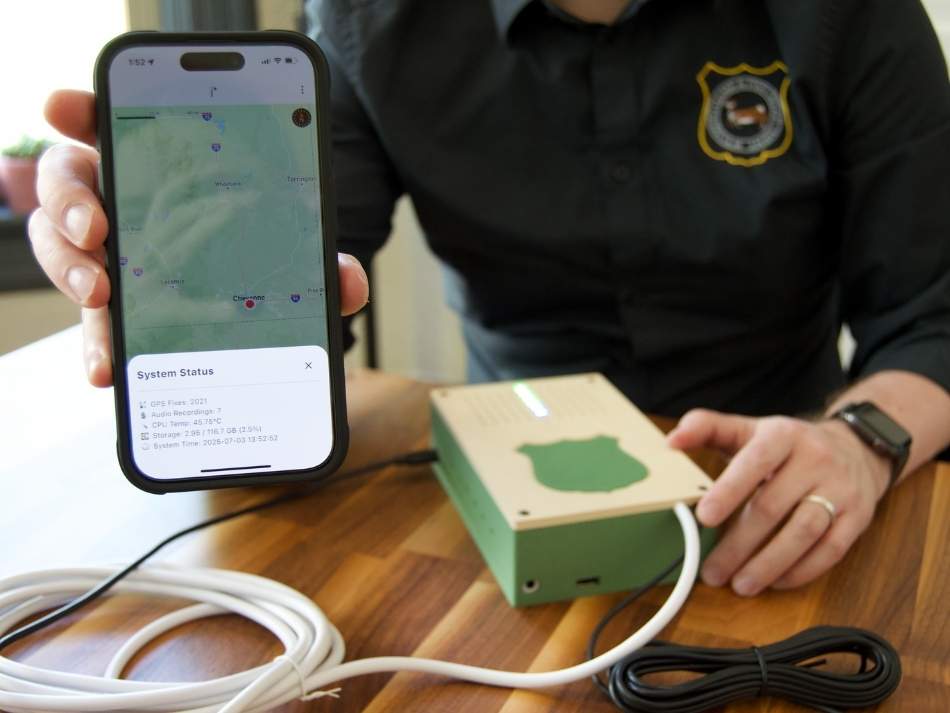
Catlin demonstrates the functionality of the J* device’s system check. It is designed for researchers to test the device prior to conducting aerial surveys, ensuring the data is correctly gathered during the flight.
(Photo by Hannah Guthrie)
For researchers like Hall, the autonomy to develop new technology and explore innovative research methods is a vital component of SRA’s work for Game and Fish.
“We are allowed to take some risks if we, alongside managers, feel the gains will make the risks worth it,” Hall said. “And that is the way you do science, right? You try things, you figure out what works and what doesn’t work, and then you try again and make it better. And I think having that sort of broad support within the agency and from our partners helps us deliver something better and useful.”
Game and Fish wildlife managers are seeing the positive effects of the streamlined process and advances in technology brought about by the unit.
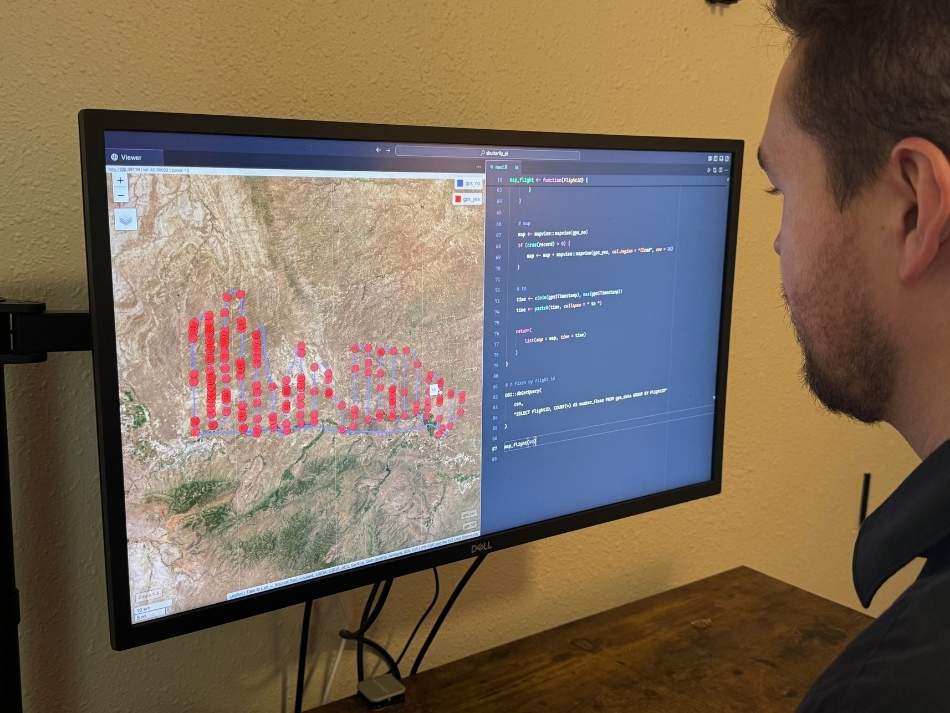
Catlin reviews data collected by the J* during a pronghorn line transect survey, a method used to estimate pronghorn abundance. (Photo by Hannah Guthrie)
Pinedale Region Wildlife Coordinator Brandon Scurlock said while field biologists possess deep regional knowledge, the time lag in integrating this expertise with cutting-edge data analysis methodologies often presented a challenge — a gap now effectively bridged by SRA.
“Working in the field is a full-time job, as is staying up to date with the latest technologies to analyze the data we gather,” Scurlock said. “Methods for data assessment are constantly evolving, so having SRA on hand to analyze the information we gather has been incredibly valuable to our work.”
The increased and more refined data is also assisting landowners and developers who are considering projects in and around critical habitat areas. While Game and Fish is not a regulatory agency, it is often called on to provide recommendations to land managers and project proponents to assist in creating plans that minimize the negative impacts on wildlife.
“Being able to show a detailed map of big game movements derived from GPS collars is more defensible than what we had before, where the data would be handwritten on a map,” Scurlock said. “We are now able to present data that is incredibly sophisticated and detailed, and that is hard to argue with.”
Ultimately, helping present accurate data that shows a clear picture of wildlife in Wyoming is an important step in helping Game and Fish stakeholders understand the work the agency is doing and the recommendations that are made. Finding effective answers to complex wildlife management questions is rarely simple. It often demands years of dedicated research and significant effort. While this inherent challenge will always remain, SRA plays a crucial role by streamlining the path to those answers and providing essential, practical support to Game and Fish regions across the state. This continuous commitment to delivering timely and precise scientific insights ensures Game and Fish can make the most informed decisions for Wyoming's wildlife.
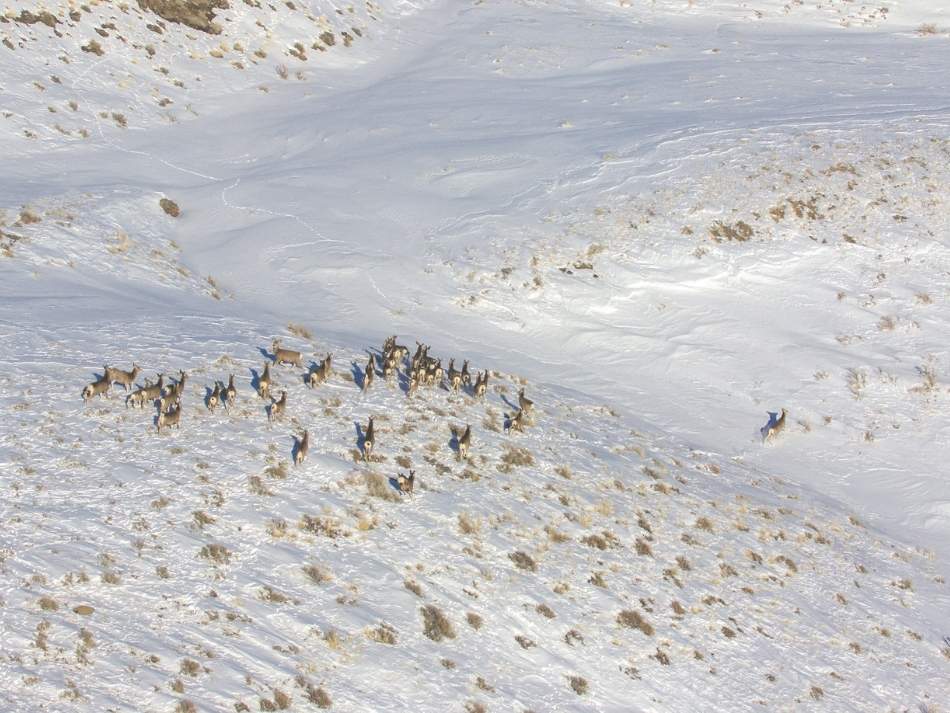
A mule deer herd near Beaver Creek in the Cody Region during a sightability survey in February 2023. (Photo by Stan Harter/WGFD)
For agency personnel, one of the most exciting possibilities SRA brings is the next wave of research and development methods for Game and Fish, reshaping how field managers approach research and development for the agency.
“SRA should continue to grow in capacity and evolve in techniques,” Scurlock said. “Ultimately, this is a great thing for the department. Even some of our most seasoned biologists that have been doing things the same way for a long time can look at these new technologies and methods and realize efficiencies.”
— Amanda Fry is the public information officer for the Wyoming Game and Fish Department

